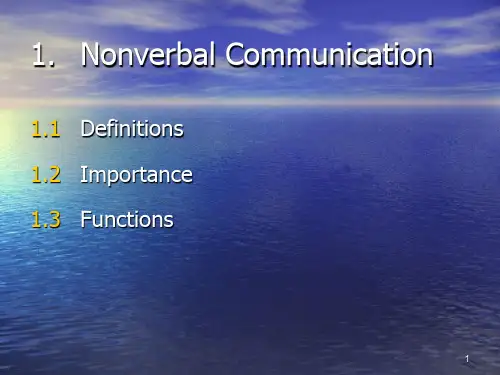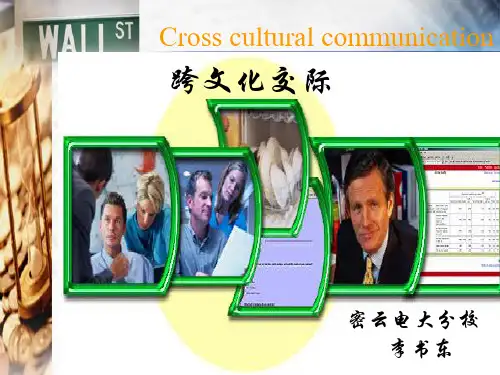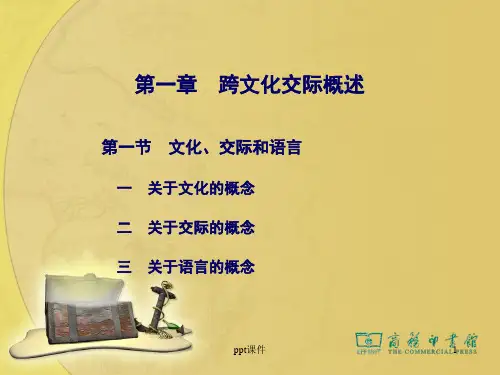- 1、下载文档前请自行甄别文档内容的完整性,平台不提供额外的编辑、内容补充、找答案等附加服务。
- 2、"仅部分预览"的文档,不可在线预览部分如存在完整性等问题,可反馈申请退款(可完整预览的文档不适用该条件!)。
- 3、如文档侵犯您的权益,请联系客服反馈,我们会尽快为您处理(人工客服工作时间:9:00-18:30)。
Compare the following two spoken discourse and decide which one might be given by a Chinese and which by an American? A. Because most of our production is done in China now, and it’s not really certain how Hong Kong will be like after 1997, and since I think a certain amount of caution in committing to TV advertisement is necessary because of the expense. So, I suggest that we delay making our decision until after Legco makevery people a cup, cup of clay, and from this cup they drank life… They all dipped in the water, but their cups were different. ---- R. Benedict
Low-context Culture:
• In low-context messages, the majority of the information is vested in the explicit code.
• Examples of low-context cultures include English, North American, German, etc.
Summary: language and culture
• Language is a reflection of culture, and culture is a reflection of language. • Culture influences language by way of symbols and rules for using those symbols, as well as our perceptions of the universe (the meaning associated with the symbols). • Language, on the other hand, would seem to have a major impact on the way an individual perceives and conceptualizes the world.
How different thinking patterns affect our life?
• Western medicine Vs traditional Chinese medicine • Western cooking • Different views on contracts - Westerners value objectivity, specificity and precision and make sense of the world by reasoning and analyzing. - Chinese are more subjective and value intuition a lot, through which they get an insight into things around them.
6. Intercultural Communication
• Samovar & Porter
Intercultural communication is communication between people whose cultural perceptions and symbol systems are distinct enough to alter the communication event. intercultural communication refers to any communication between two members of any cultural communities.
1. What is culture?
On the surface: customs and behavior More deeply: what the behavior and customs mean to the people who are following them In a word: Culture is all about meanings Hall: Culture is everything and everywhere
High-context Culture:
• In high-context messages, meaning is not necessarily contained in words. Information is provided through gestures, the use of space, and even silence. Meaning is also conveyed through status (age, sex, education, family background, title, and affiliation). • Examples of high-context cultures include Chinese, Japanese, Middle Easterners, etc.
message / channel
decoding
encoding
Sender Receiver
noise
Sender Receiver
encoding
message / channel
decoding
Feedback is essential to good communication
5. Characteristics of communication
Inductive pattern (topic delayed)
4. Communication Styles and Culture
Which is given by a Chinese? Which by an American?
B. I suggest that we delay making our decision until after Legco makes its decision. That’s because I think a certain amount of caution in committing to TV advertisement is necessary because of the expense. In addition to that, most of our production is done in China now, and it’s not really certain how Hong Kong will be like after 1997.
4. What is Communication?
• It comes from the Latin word “communicare”, it
means to give or to exchange. Now, the most common meaning of “communication” is to give or exchange information or ideas. • Communication is our ability to share our ideas and feelings. (the basis of all human contact) • Communication is a dynamic, systematic process in which meanings are created and reflected in human interaction with symbols. (J.T.Wood)
Intercultural Communication Vs Cross-cultural Communication • Cross-cultural communication the similarities and differences in value orientations, affective dispositions, relationship management, communicative styles (psychological process) • Intercultural communication the penetration by a member of one culture into another culture (practical significance)
Mode of Communication
Linear Model of Communication
noise
encoding decoding
Sender
Channel (message)
Receiver
Is this an effective model of communication?
Interactive Model of Communication
• 1) Communication is dynamic • 2) Communication is interactive • 3) Communication is irreversible • 4) Communication takes place in both a physical and social context.










